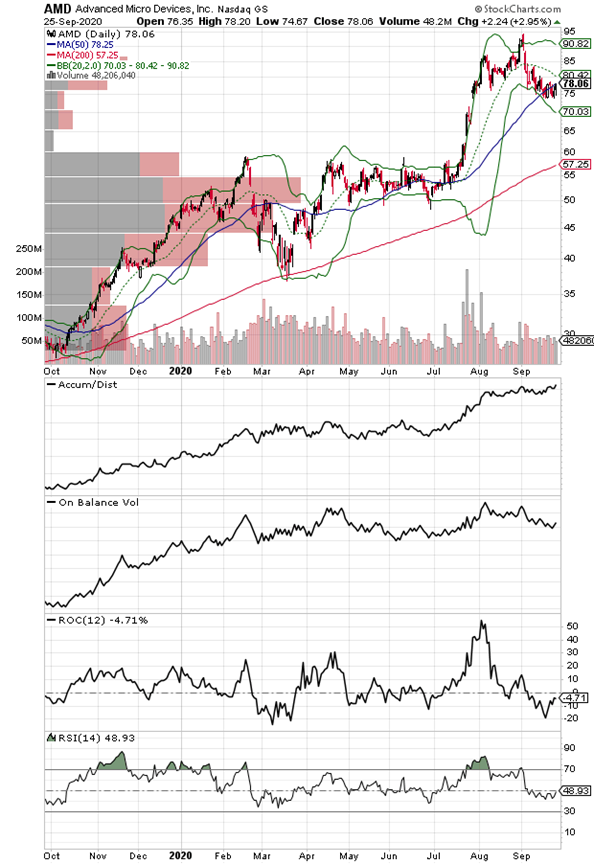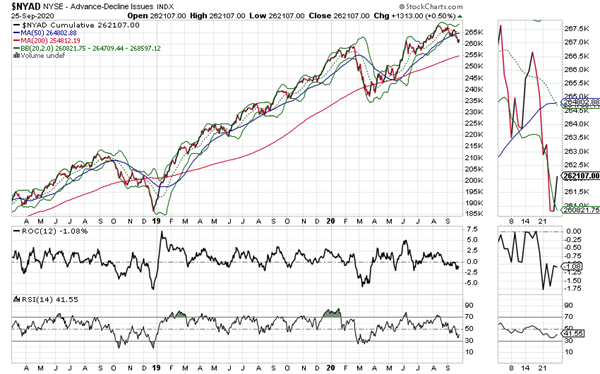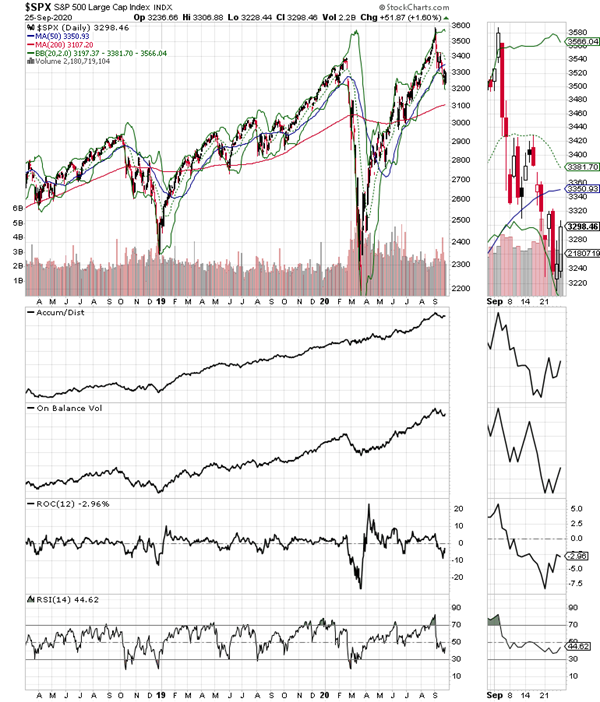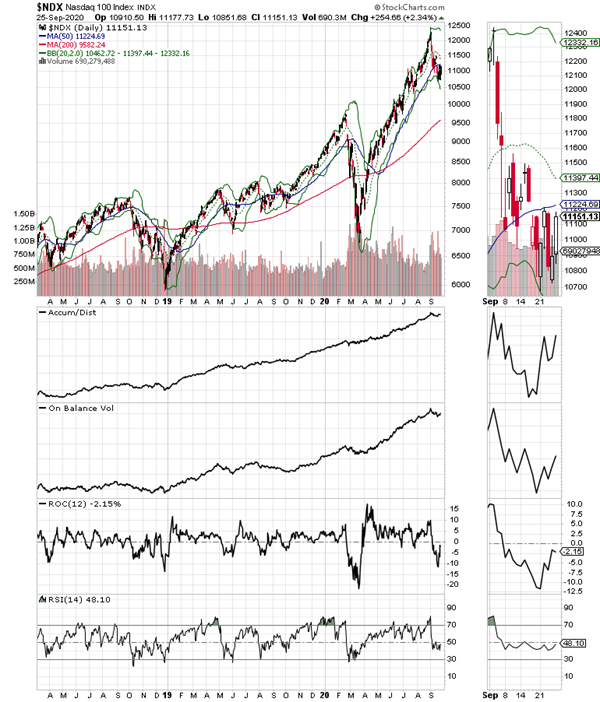In a market controlled by algorithmic traders (algos) any bottom can be a V bottom or not, states Joe Duarte on In the Money Options.
So instead of taking chances by buying in too early and getting hurt this is a good time to be a vigilant contrarian and to be ready to make a move, especially when, as I describe below there is some evidence that dip buyers are moving quietly into the market as prices fall.
And while there is the potential for a rebound of some sort in the short term, as the stock market is moderately oversold, a high level of bearish sentiment is now in place, and there is evidence of dip buying in some areas of the market, caution remains warranted. Nevertheless, when the Federal Reserve continues to pump money into the banking system at the tune of $120 billion per month the monetary background for stocks remains bullish.
Remember, panic and capitulation are often the predecessor to a buying opportunity. So, while the reflexive move may be to panic, history shows that a market run by high frequency trading (HFT) machines can turn on a dime.
Algo Trading Primer
Even during extreme selloffs investors should remember that in an algo controlled market, all trends and events such as market tops and bottoms are exaggerated by the computer programs and the instructions imparted to the machines have a wide set of contingencies “if this happens, do this” instructions built-in. Moreover, consider the fact that HFT algos are programmed to do two things: front run the money flow, up or down, and accelerate the prevailing trend in order to catch as many investors as possible off guard and create profitable opportunities for the HFT firms.
That means that while in an up market the machines buy stocks just before traders in order to sell shares at a higher price, in a down market based on HFT’s early knowledge of the direction of the dominant order flow, the algos sell stocks short just before traders sell their shares. After the machines have established a short position or have hedged their position via options then they buy shares from investors and immediately sell them to someone else for a lower price, making money on each step of their strategy. And the more sellers that appear, the more times the HFT machines repeat the exercise until the selling stops at which time they start to tempt the buyers with higher prices on low volume (spoofing) and then wait until the buyers appear in force in order to repeat the cycle to the up side.
So, because the market is now nearly oversold, and short interest is rising stocks now have the potential to bounce higher as the algos start to probe how much buying interest there is in the market. In other words the market is now a day to day affair where if investors take the algo’s bait and start buying things can heat up to the up side in a hurry or where if there are no buyers the down trend is likely to resume.
Sound Trading Principles Help Guard Against Algo Antics
Sure, dealing with algos can be daunting. Yet, this is not a time to panic. Instead it is a good opportunity to be patient because eventually as the sellers get exhausted the algos will sense the reversal of the order flow and a tradable bottom will be pretty clear. The only question is when.
Therefore, this is a time when sticking to sound trading principles and risk management is more important than ever in order to prepare for the day when the algos decide that the market is truly oversold and start the next upswing. So here are our sound trading principles again, just for review:
- Don’t fight the Fed – especially if the central bank increases its open market operations and increases the amount it injects into banking system beyond $120 billion per month
- Don’t fight the market’s dominant trend and momentum – downtrends require risk management not aggressive buying but prepare for a turn in the trend
- When the trend turns look for strong stocks in strong sectors – when there are no strong stocks there is no reason to be buying until things improve
- To minimize portfolio volatility, if you must trade, trade in small to moderate share lots
- Take profits on 20% winners in any market, as I recommended all the way up in this market before it turned lower
- Use 5-8% sell stops and monitor each position individually – thus if a stock is holding above its sell stop there is no reason to sell it as it is showing relative strength.
- Monitor down sectors for possible turn around stocks to consider and build a shopping list for the next uptrend
- Use sound money management principles – let the market stop you out and, in this way, you will raise your cash reserves for the next buying opportunity
- Consider options as risk management tools
Moreover, as I discuss directly below, the current market is now a more fertile ground for well-designed option trades.
Using Options during Troubling Markets
The current market environment offers the potential for, above all things, risk management, which is why using well designed option trades, such as the relatively low risk Buy-Write or covered call strategy. Certainly, no trade, optionable or otherwise is risk free, which is why stating the goal of the strategy and the best place to use it are paramount.
The Buy-Write covered call strategy involves buying a stock and selling a call option simultaneously. The goal is to reduce the risk of loss if the price of the stock goes down by collecting the premium of the option sale, although the trade is not without risk and the maximum gain for the combined position is limited. The best time to use the strategy is when there are stocks whose chart patterns suggest that the stock is likely to form a base, or move sideways for at least the period of time until the expiration date of the option.
Here is an example of such a stock on which I recently recommended a covered call strategy, computer microprocessor company Advanced Micro Devices (AMD). AMD was a historical also ran for years until it became the semiconductor sector market darling over the last year by improving its financial position and taking market share from industry leader Intel (INTC)

But lately investors took profits on the stock aggressively until the market trend truly accelerated to the downside. Since then, AMD has started to move sideways as long-term money has been buying the dip.
And it is that base forming trading pattern, in the wake of a rising Accumulation Distribution (ADI) and a bottoming out of On Balance Volume (OBV) which makes AMD a great stock to use in a Buy-Write strategy because when timed properly the option will likely expire worthless. Moreover, if the stock’s price remains fairly stable the investors will get to keep the premium for a profit.
Of course, the stock could break out of its trading range, either up or down, which is why the trade has to have some conditions and preset limits in order to prevent large losses.
Here are four key components of a successful Buy-Write strategy:
- Look for a stock in a basing pattern
- Seek an option which is slightly out of the money
- Choose a stock whose implied volatility is above its historical volatility
- Put time on your side by choosing an option which is as close to 45 days from its expiration date as possible
NYAD Nears Oversold but Remains in Sell Signal Territory
The New York Stock Exchange Advance Decline line (NYAD) finally bounced back on 9/25/2020. And while that was an encouraging first step, it is nothing to get too excited about just yet, at least not until we get the all clear signal.
As I’ve noted here in the past few weeks NYAD had been closing in on a sell signal as the RSI for the indicator had been below 50 for some time. Now the RSI’s warning was confirmed by the NYAD itself breaking decisively below its 50-day line delivering a full-blown Duarte 50-50 sell signal.
This is the fourth sell signal for this indicator since the 2016 presidential election with each of the previous three (listed in bullets below) preceding significant market declines:
- February 2018
- October 2019
- February 2020 and now
- September 2020

The S&P 500 (SPX) is also well below all kinds of support levels now and unless things change, as they well could, it may be headed for a test of its 200-day moving average near 3100. Resistance is at the 50-day moving average now near 3150.

The Nasdaq 100 (NDX) has some support at 10,000 but could still move toward 9500, its 200-day moving average. Still, NDX has formed a potential short-term bottom so we will see what happens there, especially between the 11,225 and 11,400 area.

Still, there are some positives for sure as Accumulation Distribution (ADI) and On Balance Volume (OBV) for both NDX and SPX suggest that some money is moving in on this selloff.
The bottom line is that we are seeing our first bounce after some very aggressive selling and it’s difficult to know which way things will break next, although with the algos there is always the potential for a V bottom, especially with OBV and ADI suggesting that dip buyers are increasingly present.
However, if SPX and NDX break below their 200 day moving averages convincingly, the market decline could well accelerate significantly, and we may enter a true and uncontested bear market.
Stay Patient. Monitor Individual Positions. See what the Fed Does. Make a Shopping List.
Investors who have managed their portfolio well have seen their cash levels rise through prudent profit taking before the market break and through the judicious use of sell stops in remaining positions.
The next step is to manage the current risk in the market, both through raising cash as called for, and using specific option strategies as we wait for the market to bottom. Finally, given the current scenario it would not be surprising to see the Federal Reserve resort to an increase in its money infusions into the banking system. If that’s what happens, the next logical step is to see how much money they put in and how the algos react.

In fact, both SPX and NDX have already delivered their own version of the 50-50 sell signal, which should raise concern among investors, unless these events are not reversed.
Don’t Fight the Fed but Be Selective and Consider Options
With stock market valuations near record highs and a bumpy election taking shape, it seems counterintuitive to wish to buy stocks. But in some cases, that’s the current situation faced by investors. And to be frank, given the potential for rapid market swings, the current market is not for everyone.
Nevertheless, active investors should continue to cautiously trade the dominant trend which until it is clearly reversed remains to the upside as the Federal Reserve’s easy money works its way into the stock market moving stocks higher. Of course, given the fact that a fool and his money are soon parted, it is imperative to follow sound trading principles including sticking to strong stocks in strong sectors, to deploy well applied sell stops, and to stay disciplined by taking profits where appropriate, while also trading in small to moderate lots in order to prevent portfolio volatility.
Finally, as stock prices have come down, the spread in the options market have improved and due to increasing participation by individual investors liquidity seems to have improved a bit. What that means is that it’s a good time to use options once again as risk management and income vehicles.
To learn more about Joe Duarte, please visit JoeDuarteintheMoneyOptions.com.





















